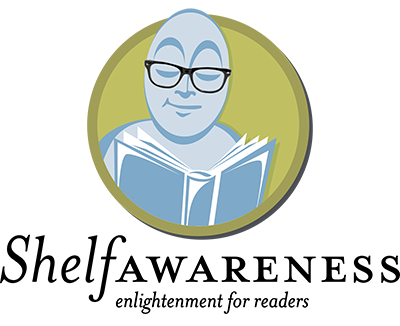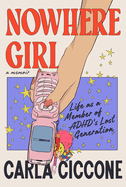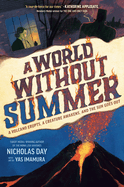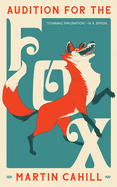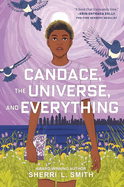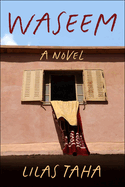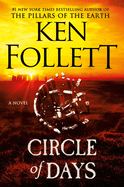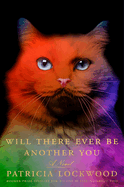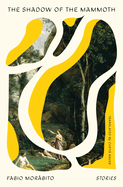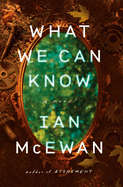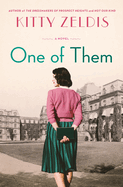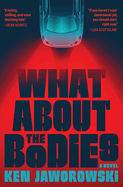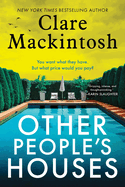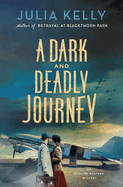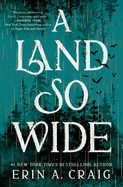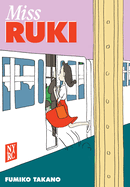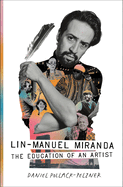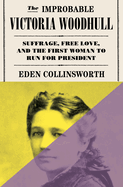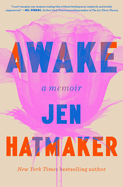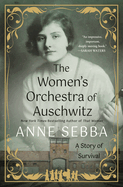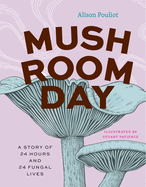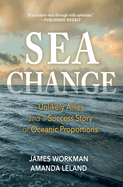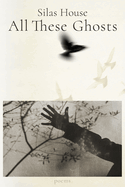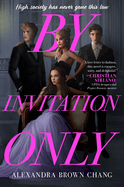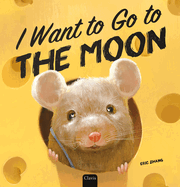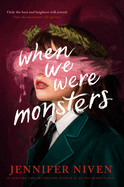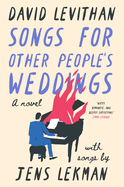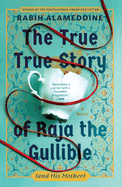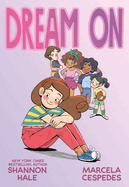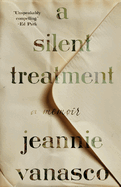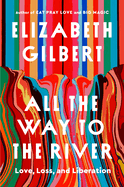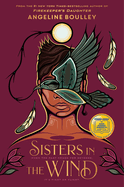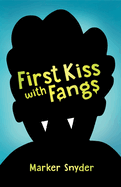In this week's issue, Carla Ciccone's "smart, compelling" memoir Nowhere Girl: Life as a Member of ADHD's Lost Generation places her personal diagnosis into historical, scientific, and cultural contexts. Meanwhile, Martin Cahill's "short and exquisite" fantasy Audition for the Fox follows one woman through the trials of revolution at the behest of a trickster god. And in Circle of Days, novelist Ken Follett crafts a "thoroughly researched, engrossing, and richly imagined novel about the creation of Stonehenge." Plus, for young readers, A World Without Summer: A Volcano Erupts, a Creature Awakens, and the Sun Goes Out is Nicholas Day's "dramatic, enlightening work of nonfiction" about the catastrophic fallout from a "world-altering" volcano explosion in the 19th century, with immersive grayscale illustrations by Yas Imamura.
Waseem
by Lilas Taha
Waseem perceptively centers a Palestinian community's resilience in a Lebanese refugee camp. Author Lilas Taha infuses surprisingly poignant charm, reclaiming joy even if "it made little sense in this miserable world."
"I shall tell you lies," the titular Waseem opens. He's the firstborn son who should have been named Saleem, meaning " 'physically healthy'... [but] the kindhearted neighborhood midwife wanted to spare [him] ridicule." Born with "a number of handicaps"--he can't walk, he limits his speech to grunts--he expands his world by reading "anything that came to [him]." He's "crippled, but not helpless," a keen observer and holder of secrets, which he learns to wield as a "means to force someone's hand," usually to counter cruelty. Throughout Waseem's life, "noble Ameena, the girl who brought [him] gifts in her panties"--mostly books!--is his enabler, savior, and heart-wrenchingly elusive love. Her sheer force of will catapults him into a UN Relief and Works Agency medical program in the Netherlands, which allows him to move without a walker. His arrival back in Lebanon lands him amid relentless chaos, and life goes on: his widowed mother's unquenchable longing for her childhood Yaffa oranges, his siblings' sagas of quotidian endurance, his neighbors' tribulations of conflict and abuses.
Taha, a Palestinian Syrian American by way of Kuwait, clearly understands displacement and an impossible yearning for homelands long gone. Waseem is her cipher who, in turn, shares the "lies" his family and community tell to stay alive. Briefly, Taha presents Ameena with agency, to reveal a life beyond camp and, when Waseem is silent, why she must return to share the last laugh. --Terry Hong
Discover: Lilas Taha empathically presents the uncertain lives--marked by misery, but also humor, laughter, joy--of a Palestinian community trapped in a Lebanese refugee camp.
Circle of Days
by Ken Follett
Ken Follett (The Pillars of the Earth) is sure to delight his dedicated following and add new readers with Circle of Days, a thoroughly researched, engrossing, and richly imagined novel about the creation of Stonehenge.
Follett, whose research included access to recent archeological studies, reimagines late-Neolithic Britain as divided into communities of farmers, herders, and woodlanders. Overseeing all of these groups are the priestesses, who use their understanding of mathematics and the wooden "Monument" where they conduct their rituals to predict eclipses, equinoxes, and solstices. The novel is filled with fascinating details of daily life in a time before the wheel, including the backbreaking work of mining flint for tools, the creation of fermented food that could be stored without spoiling, and a festival where men and women have sex with strangers outside their communities to prevent inbreeding. Of course, each community has its own interests, and the farmers emerge as the most territorial and warlike. When a dispute ends in a fire that destroys the Monument, it falls to Seft, a flint miner and brilliant engineer, and Joia, a visionary priestess, to work out how to transport and construct a permanent circle of stones.
While Follett's colorful historical detail makes Circle of Days a captivating trip back in time, it is his carefully drawn characters and intricately plotted storyline that make the novel an irresistible read. As an added bonus, he offers readers an intriguing explanation for the enduring mystery of Stonehenge. --Debra Ginsberg, author and freelance editor
Discover: This richly imagined and engrossing novel about the creation of Stonehenge is sure to delight author Ken Follett's many fans and add new ones to his readership.
Will There Ever Be Another You
by Patricia Lockwood
In Patricia Lockwood's head-spinning second novel, Will There Ever Be Another You, a writer gingerly moves past family tragedies but becomes mired in ill health.
Lockwood's debut novel, No One Is Talking About This, was on the Booker and Women's Prize shortlists and won the Dylan Thomas Prize. Both books are effectively third-person autofiction; this sequel picks up after the death of the author's niece in infancy from a rare genetic disease. Still raw and reeling, the family heads overseas, hoping a vacation will be restorative. "As soon as she touched down in Scotland, she believed in fairies," the novel opens. This sets the scene for a chronicle of delusion and the unexplained.
The exceptional chapter "The Changeling" documents a clutch of symptoms, as Patricia becomes increasingly alienated from her body. She has had a fever for 48 days; she has trouble controlling her limbs. But this seems more like a mental health crisis. Memories of her brother PJ's suicide attempt suggest an explanation.
Things keep getting weirder. There is some use of the second person, but the narration mostly shifts into the first person, employing a welter of biblical and literary allusions. Although this doesn't live up to the iconoclastic humor of her poetry (Motherland Fatherland Homelandsexuals) and memoir (Priestdaddy), Lockwood is a queen of one-liners.
As pictures of disordered minds go, this is striking, but also challenging to slog through. It's difficult to find concrete details to latch onto, at least between the bookends of the trips. It's not, perhaps, how newcomers should encounter Lockwood's genius, but still essential for her fans. --Rebecca Foster, freelance reviewer, proofreader, and blogger at Bookish Beck
Discover: Patricia Lockwood's curious second novel, an autobiographical sequel to No One Is Talking About This, depicts a writer experiencing a mysterious illness and simultaneous mental breakdown.
The Shadow of the Mammoth
by Fabio Morábito, transl. by Curtis Bauer
Connections--desired, attempted, disregarded, missed--loom throughout Fabio Morábito's outstanding 18-story sophomore collection, The Shadow of the Mammoth, reprising similar themes found in Mothers and Dogs (2023). Once again, poet/academic Curtis Bauer adroitly translates.
Tunnels are literal links, although their manifestation has unexpected results in five stories. In "The Great Floating World," the construction of a "floating highway, made up of fifteen tunnels" causes significant deaths, including a royal demise. A tunnel-like trash chute brings neighbors together in "Time to Take Out the Trash." In "Wildlife Crossing," an under-the-airport passageway for animals becomes a satiating haven for an aging lion--and an international point of contention for humans. In "Daedalus Under Berlin," masons construct tunnels intended as deathtraps for escapees fleeing to the West from the East. A birthday tortoise comes to symbolize the "The Mont Blanc Tunnel," inspired by two tunnel workers' "sturdy friendship."
Translations are also meant to connect--but don't. Translation doesn't bridge languages so much as cause miscommunication in "The Sadness of Translation" and "Letters to the Queen." In the concluding titular story, Morábito juxtaposes two distinct narratives--a prehistoric cave painter who's also a polyglot tribal mediator and a contemporary middle-aged translator in a seventh-floor apartment--which slyly seems to require readers to personally establish potential linkage.
Morábito--his own Egypt-born, Italy-raised, Mexico-domiciled history a peripatetic patchwork--creates in-between, elliptical spaces from which he provokes his characters' (and readers') reactions. Whether by concrete or ethereal means (blank wall space, sleep, dark waters), Morábito continues to probe, searching for opportunities to make contact and possibly, hopefully, momentarily touch. --Terry Hong
Discover: Fabio Morábito's second collection of 18 stories impressively examines elliptical attempts to connect that end in success, failure, but more often something in between.
What We Can Know
by Ian McEwan
What We Can Know is a psychologically acute story wrapped in a tantalizing literary mystery, and it serves as evidence that Ian McEwan (Atonement; Nutshell) is still producing serious fiction that compares favorably with the best work from his long career.
The novel begins in 2119, in an England that's been transformed into an archipelago following a 2042 event known as the Inundation. Earth's population has fallen below four billion, clashing warlords vie for North American territory, and a dominant Nigerian empire controls the Internet. At a British university, Thomas Metcalfe, a humanities professor, is obsessed with a poem entitled "A Corona for Vivien." The poem was a gift from eminent English poet Francis Blundy to his wife on her 54th birthday. Written in Blundy's hand on vellum, it was never published, and the only known copy has vanished amid conflicting claims of its whereabouts.
Metcalfe's description of his search merges seamlessly with a subtly moving meditation on the struggle to preserve a collective memory of the best of civilization's culture on a climate-ravaged, economically diminished planet. At every turn, What We Can Know satisfies expectations even as it generates fresh anticipation. Its keen insights about some of the darkest and most mystifying aspects of the human psyche are presented in the way one would expect from a novelist of Ian McEwan's experience and talent as he leads readers through the complex emotional labyrinth of this memorable story. --Harvey Freedenberg, freelance reviewer
Discover: In a post-apocalyptic England, a humanities professor seeking to solve a literary mystery discovers a tangled story of love and betrayal.
One of Them
by Kitty Zeldis
Kitty Zeldis's insightful third historical novel, One of Them, explores the complexities of Jewish identity through the lives of two young women in the years after World War II.
As a student at Vassar College in 1946, Anne Bishop is determined to hide that she's Jewish from the other students, who often make antisemitic remarks within earshot. But Anne is drawn to Delia Goldhush, a confident, sophisticated fellow student whose Jewish identity is public knowledge. When Anne participates in an act of cruelty against Delia, their tentative friendship shatters. However, the girls reconnect unexpectedly in Paris, where they both become involved in finding information about Delia's sculptor mother, Sophie, who went missing during the war. Zeldis's narrative follows both young women to Palestine, where the 1948 declaration of Israel as a Jewish state sends tensions flaring.
Zeldis (The Dressmakers of Prospect Heights) shifts between Anne's and Delia's perspectives, delving into Anne's grief and isolation following her father's death and Delia's wartime escape from Paris with her own father. Delia is shocked to discover her mother is still alive, and her search for Sophie will bring other uncomfortable truths to light. Anne wants to atone for her actions by helping Delia find her mother; her time abroad also challenges her worldview in other ways. Both young women return to the U.S. with changed perspectives: on Judaism, families, and their own future career paths. One of Them is a thoughtful chronicle of growth and friendship, and an examination of several facets of Jewish identity. --Katie Noah Gibson, blogger at Cakes, Tea and Dreams
Discover: Kitty Zeldis's insightful third novel explores the complexities of Jewish identity through the lives of two young women who meet at Vassar College.
Mystery & Thriller
What About the Bodies
by Ken Jaworowski
In Ken Jaworowski's engaging, character-driven novel What About the Bodies, three people stymied by unfulfilled lives strive to find meaning in economically depressed and "unfeeling" Locksburg, Pa.
Single mother Carla Louden, who has always worked as a waitress, may finally realize her dream of owning a restaurant as she converts an old barn with the help of one employee she's hired and her college-age son, Billy, on whom she dotes. All her life, Liz Moyer has followed her dream of being a singer-songwriter, but she's broke. Liz might find success if she can get her 15-year-old breakdown-prone Chevy to Nashville, where a powerful producer wants to hear her music. Meanwhile, 20-year-old Reed Grove, who is autistic, wants to slip a doll he made in the third grade into his mother's casket, which is locked in a mausoleum, before his brother, Greg, sends him to a care facility in Pittsburgh. Along their individual odysseys, each will meet with violence and obstacles that may be insurmountable. Billy, who earned a full scholarship to MIT, has a secret that may ruin his and Carla's lives. Liz owes a vicious ex-con money. Reed faces rumors that he caused his mother's death.
Jaworowski alternates among his character's perspectives, setting up What About the Bodies as a series of vignettes that have the microcosmic depths of short stories. Each character is heartbreakingly close to ruin as brutality seeps into their lives. The trio's goals seem small but are individually significant. Jaworowski delivers a scintillating tale about three people attempting to rise above their limitations, adding an extra punch when they finally meet. --Oline H. Cogdill, freelance reviewer
Discover: In this engaging, character-driven novel, three people attempt to rise above their limitations in a small town, each coming heartbreakingly close to ruin as brutality seeps into their lives.
Other People's Houses
by Clare Mackintosh
Fans of British crime novels may have noticed that one part of Great Britain is underrepresented. Helping to redress the balance is Clare Mackintosh (I Let You Go), an English writer who lives in Wales, the part-time setting of Other People's Houses, the uncommonly adroit third title in the Detective Constable Ffion Morgan series.
Other People's Houses begins with North Wales Police's DC Ffion Morgan learning that a dead female body has been found in a kayak that was stolen from a rafting center; meanwhile, Ffion's English boyfriend, Detective Sergeant Leo Brady of the Cheshire Criminal Investigation Department, learns of a burglary on the Hill, the Park Avenue of Tattenbrook, West Cheshire. It's the second burglary on the Hill in six months, which wouldn't be noteworthy if on both occasions the thief hadn't skipped over valuables in favor of making off with a few small, inconsequential-seeming items.
Ffion's and Leo's separate investigations come together more easily than their separate cultural identities (Leo is learning Welsh to placate Ffion's mother): as it turns out, the murdered woman was an estate agent who had a connection to the Hill, as does Leo's social-climbing ex-wife. (There's a solid running gag about her insistence that living around the corner from the Hill amounts to Hill-resident status.) Other People's Houses incorporates all these story strands into a latticework, a feat as impressive as Mackintosh's other major accomplishment: convincing readers that the irascible Ffion (whose "preferred communication method" is arguing, according to one colleague) is worthy of Leo's starry-eyed devotion. --Nell Beram, author and freelance writer
Discover: The uncommonly adroit third book in the DC Ffion Morgan series finds North Wales Police looking into a murder linked to a burglary in West Cheshire that's being investigated by Ffion's boyfriend.
A Dark and Deadly Journey
by Julia Kelly
Julia Kelly's smart, twisty World War II mystery A Dark and Deadly Journey sends British intelligence agent Evelyne Redfern and her partner, David Poole, to Lisbon to investigate the disappearance of a mysterious informant. Before they even leave the airport, Evelyne discovers a dead body with a connection to their case; a murder investigation, naturally, proves both tempting and complicated. Unbeknownst to David, Evelyne is also searching for her estranged father, who recently instructed Evelyne to take a cache of her late mother's valuables to a London jeweler--who then ended up dead. Evelyne must navigate the murky waters of professional ethics, personal interests, and her growing attraction to David in a city famous for its wartime complexities.
In this third series installment, Kelly (A Traitor in Whitehall) builds on Evelyne's previous adventure in Betrayal at Blackthorn Park, which left Evelyne with a gunshot wound and a keener appreciation for the dangers and drama of spy work. Though Lisbon is supposedly neutral, David and Evelyne encounter both Allied and Axis agents, not to mention Portuguese citizens whose loyalties are in question. They scour the city for their missing man and Evelyne hunts for clues about her father's whereabouts, unsure where his political sympathies lie. As they crisscross the city, frequenting humble cafes and elegant casinos, Evelyne and David must discern which of their new acquaintances is truthful and which ones could prove deadly.
With an intriguing puzzle of a plot and a sharp, witty narrator in Evelyne, A Dark and Deadly Journey is a tense, well-crafted wartime adventure. --Katie Noah Gibson, blogger at Cakes, Tea and Dreams
Discover: Julia Kelly's smart, twisty World War II mystery sends a pair of British intelligence agents to Lisbon, a city whose neutral facade hides complicated secrets.
Science Fiction & Fantasy
Audition for the Fox
by Martin Cahill
Martin Cahill's Audition for the Fox is a brief, lyrical story about the power that exists where the powerful never think to look and fighting for justice even when it seems hopeless.
After 96 auditions where she failed to gain the patronage of one of the 99 Pillars of Heaven, Nesi is desperate enough to turn to the trickster god, T'sidaan the Fox. The Fox sends their would-be acolyte 300 years into the past, during an era of the brutal Zeminis occupation of Nesi's homeland, Oranoya, and tasks her with igniting the spark of revolution. Nesi realizes this will not be an easy feat when she awakes to a life of harsh labor in a fortress guarded by the Wolfhounds of Zemin, worshippers of the banished Pillar, the Wolf of the Hunt. As she learns about the horrors of her homeland's past, the kindness her fellow Oranoyans hold onto in spite of everything, and the role of trickery in the face of brute force, Nesi gains the courage to set her country on its path to freedom and prove herself worthy of T'sidaan's patronage.
Written in the style of a folktale and interspersed with legends told by characters within the story, Audition for the Fox is an exquisite tribute to ordinary people who act because "someone has to do something, and if [they're] not that someone, nothing will happen and nothing will get better." Nesi's and T'sidaan's narratives both include heart-wrenchingly sad moments, but joy also abounds in this short novel. --Dainy Bernstein, freelance reviewer
Discover: In this short and exquisite fantasy novel, a young woman thrust into a brutal past by a trickster god learns about the power of trickery and guile in the face of cruelty and oppression.
A Land So Wide
by Erin A. Craig
In A Land So Wide, Erin A. Craig's atmospheric first fantasy novel for adults, a young woman leaves her isolated village to save the man she loves and learns along the way that monsters are far closer than she imagined.
Greer Mackenzie lives in the troubled town of Mistaken in an alternate version of 1700s northern Canada. For almost 100 years, Mistaken has been protected by the Benevolence who gifted them magical warding stones that keep the monsters out and the villagers in. The night before she plans to marry Ellis Beaufort, her beloved, Greer sees him disappear across the village boundaries, something that shouldn't be possible. Fleeing her father's demands and the secrets that have kept her trapped her whole life, Greer follows Ellis. Her journey into the massive forest, which has lured so many would-be settlers to their deaths, brings her closer to the monsters known as Bright-Eyeds--and her own past--than ever before. Will it also bring her to Ellis?
Along with their customs and saws, the settlers brought something else from their European homeland, and Craig (Small Favors) deftly connects her shape-shifting terrors with the legacy of failed settlements in the "new world." A Land So Wide contains the same eerie, cramped atmosphere as Craig's young adult novels, as well as similar themes of self-discovery, liberation, and wanderlust, but the romance and violence are more mature. This novel will satisfy Craig's existing readers while winning her an audience hungry for historical fantasy, bloodthirsty creatures, and a love as dark and vast as an old-growth forest. --Suzanne Krohn, librarian
Discover: In an alternate 18th-century Canada, a young woman flees her magically protected village to follow her beloved and must battle monsters and a monstrous family legacy to save them both.
Graphic Books
Miss Ruki
by Fumiko Takano, transl. by Alexa Frank
Vivaciously subversive Miss Ruki, created by Fumiko Takano and charmingly translated into English by Alexa Frank, hasn't aged since her June 1988 debut as a serialized character in Japan's weekly women's magazine Hanako. During Japan's late-1980s bubble economy, single women with disposable incomes became significant consumers, setting trends and boosting the economy.
Miss Ruki seemingly falls into this self-sufficient demographic. But from the introductory panels, she is a different level of independent: she works from home, her 1960s hairstyle shouts anachronism, fashion isn't in her vocabulary, and her attention tends toward the library's latest offerings or the post office's newest stamps. Her best (and only?) friend, Etsuko, is the too-aware stylist, attending exclusive gatherings (and dragging Ruki along in coordinated outfits) and keeping a calendar of golf sales and salon visits. Meanwhile, Ruki can split an apple with her bare hands, trips over nothing, rolls her shorts up embarrassingly high, and encourages skipping in public. Ruki effortlessly stays true to herself, all the way through December 1992, when the comic closes.
Takano "only draws manga when she feels like it," writes Frank in her contextualizing afterword. Delightfully simple cartoons fill Takano's panels, perfectly capturing dynamic Ruki's quirky, evolving expressions. Bright colors dominate, although pink and lilac are chromatic staples. Hair color inexplicably, regularly changes for both friends--orange, brown, gray, blue, green. As if to underscore Miss Ruki's timelessness, Takano appends a final page of eight panels, dated January 2003, highlighting changes, significant and not at all. Fans of Sayaka Murata and Hiromi Kawakami wishing for a whimsical comic with girl-power bite will particularly appreciate evergreen Miss Ruki. --Terry Hong
Discover: Fumiko Takano's Miss Ruki, who debuted publicly in 1988, timelessly, delightfully skips onto English-language pages.
Biography & Memoir
Lin-Manuel Miranda: The Education of an Artist
by Daniel Pollack-Pelzner
Journalist Daniel Pollack-Pelzner traces playwright and lyricist Lin-Manuel Miranda's joyous, colorful journey in his engaging first book, Lin-Manuel Miranda: The Education of an Artist. Through extensive interviews with Miranda, his family, and numerous friends and collaborators, Pollack-Pelzner explores Miranda's drive to create, his gift for remixing disparate genres and elements to make something wholly new, and his playful pursuit of fun and learning.
Pollack-Pelzner recounts Miranda's childhood in Manhattan's Washington Heights, giving full credit to his parents for their steadfast support of his talents. He chronicles Miranda's teenage years at Hunter College High School and his university career at Wesleyan, where the musical that would become In the Heights was born. The origin story of the Hamilton juggernaut is here, too: Miranda's discovery of Ron Chernow's doorstop biography, the initial performance at Obama's White House, the show's off-Broadway debut at the Public Theater. Pollack-Pelzner's narrative also hits new notes: he emphasizes Miranda's consistent efforts to learn from anyone with whom he writes, raps, acts, or otherwise puts on a show. His "cabinet" of Hamilton co-creators and the musical's brilliant original cast make appearances, and Pollack-Pelzner also points to lesser-known inspirations, such as Miranda's Hunter teachers and high school friends. Throughout the book, Pollack-Pelzner celebrates Miranda's boundless curiosity and the "sparkling desire to entertain" that has kept him continually searching for fresh ideas.
Packed with insider quotes, enjoyable details, and musings on the artistic process, Lin-Manuel Miranda is a delightful glimpse into the mind of an endlessly ingenious creator. --Katie Noah Gibson, blogger at Cakes, Tea and Dreams
Discover: Daniel Pollack-Pelzner's engaging first book explores the creative journey of ingenious playwright, lyricist, and rapper Lin-Manuel Miranda.
The Improbable Victoria Woodhull: Suffrage, Free Love, and the First Woman to Run for President
by Eden Collinsworth
Eden Collinsworth transforms what might easily have been a straightforward biography into a riveting, page-turning romp through history with The Improbable Victoria Woodhull: Suffrage, Free Love, and the First Woman to Run for President. Readers first meet the extraordinary Woodhull as a middle-aged woman sitting in a British courtroom, contending with an intimidating attorney general who's tasked with disproving her libel case against the British Reading Room. Showcasing Woodhull at that particular moment in her life highlights her wit, savvy, and confidence. It also sets her up as an outsider: she's a litigious American, a free-loving spiritualist, and a woman.
Collinsworth presents Woodhull's unconventional life in an engaging and creative manner, including a childhood rife with exploitation by parents who presented Woodhull and her sister as clairvoyants, marriage at 14 to a man double her age, multiple cross-country moves led by visions and prophesies, and an ascent to prosperity through her and her sister's ministering to Cornelius Vanderbilt. Woodhull also started a newspaper, feuded with Harriet Beecher Stowe, started a brokerage house, ran for the presidency, and did not confine her sexuality.
Collinsworth is a thoughtful curator of historical context and details. For instance, when describing the rise of spiritualism, she quotes Mark Twain, Arthur Conan Doyle, Joseph Smith, and more. Additionally, she's careful to contextualize the unsavory and sensationalist aspects of Woodhull, creating a nuanced portrait of a woman who avoided "being accused of ambition [by claiming] that she was no more than a vessel through which an otherworldly force was acting for a greater good." Collinsworth has crafted an altogether robust and thoroughly enjoyable read. --Nina Semczuk, writer, editor, and illustrator
Discover: Eden Collinsworth's The Improbable Victoria Woodhull transforms biography into a riveting, page-turning romp through history.
Awake
by Jen Hatmaker
A spiritual renaissance accompanies devastating personal upheaval in Jen Hatmaker's eloquently crafted memoir, Awake. Whether it's recounting a middle-of-the-night discovery of shocking marital betrayal or chronicling a thriving new chapter as a single woman, Hatmaker's story offers an invaluable road map for confronting self-doubt, embracing fear of the unknown, and emerging from trauma with the capacity to love and be loved intact.
A talented writer and former pastor's wife, Hatmaker (Feed These People) hosts the podcast For the Love. The aftershocks of her divorce rippled far and wide, taking a toll on her five children as well as the church community she and her ex-husband built over decades of service. Hatmaker narrates Awake in an easy, conversational tone, expressing compassion for the role her spouse thought he had to play due to his evangelical upbringing. Her ability to laugh at mistakes is a refreshing reminder to let joy in whenever possible.
Hatmaker is candid about her own shortcomings and how she avoided asking hard questions about the state of her marriage. Her radical honesty sets the tone for readers who might be struggling to untangle the threads of their own fraying relationships. It extends to a rejection of "organized religion, once [her] happy place," while her belief in and love for the divine emerges even stronger.
Hatmaker has the remarkable ability to appreciate the lighter side of life even as she describes the shattering of her family and the terrifying loneliness of her divorce. Awake is a gift to her readers, a steadying hand through the highs and lows of seismic life transitions. --Shahina Piyarali
Discover: This eloquently crafted memoir by a podcast host and former pastor's wife recounts a devastating marital betrayal, the unraveling of a family, and the aftermath.
History
The Women's Orchestra of Auschwitz: A Story of Survival
by Anne Sebba
In The Women's Orchestra of Auschwitz, British biographer and journalist Anne Sebba presents a powerful and profoundly disturbing account of a small group of musicians who survived the Nazi death camp by performing for their lives.
There were several orchestras at Auschwitz, in keeping with the Nazi penchant for using music as a particular form of torture by, for example, making musician prisoners play marching tunes while new arrivals were led directly to the crematoria. There was, however, only one entirely female orchestra at Auschwitz-Birkenau. It was formed in April 1943 by the sadistic guard Maria Mandl, known as "The Beast," as a way to compete with her male counterparts. At first a ragtag group, the orchestra came together under Alma Rosé, a virtuoso violinist and niece of Gustav Mahler. Rosé, who led the orchestra for 10 months until her sudden death in April 1944, was an unrelenting taskmaster and often insulted players who couldn't keep up, but the women knew that, outside of the orchestra, they were doomed. "The orchestra," Rosé told them, "means life."
Sebba's research is deep and meticulous, and it includes interviews she conducted with two members of the orchestra, Hilde Grünbaum (now deceased) and Anita Lasker (age 100). What truly elevates this book, however, is Sebba's refusal to soften the horrors endured by the musicians, along with millions of others. The Women's Orchestra of Auschwitz is a stark reminder of the cruelty humans are capable of inflicting upon one another. --Debra Ginsberg, author and freelance editor
Discover: Anne Sebba's meticulously researched account of the women who survived Auschwitz by performing music in an orchestra is unflinching and powerful.
Social Science
Nowhere Girl: Life as a Member of ADHD's Lost Generation
by Carla Ciccone
When writer Carla Ciccone was diagnosed with attention-deficit/hyperactivity disorder (ADHD) at 39, she went through a range of emotions: fear, anger, disappointment, self-recognition. She catalogs this in Nowhere Girl: Life as a Member of ADHD's Lost Generation, skillfully placing her own experience in a larger historical, scientific, and cultural context. Ciccone's smart, compelling memoir is sure to appeal to anyone living with ADHD--whether themselves or someone they love.
Ciccone highlights how many of the late-diagnosed women she interviewed saw their issues "compounded" by the complexities of adulthood. As a result, she argues, "We got used to being, and feeling, invisible." This invisibility, which manifests in research and everyday life, is the central reason why Ciccone dubbed this group of women "Nowhere Girls."
Using her personal story as an entry point, Ciccone recalls childhood scoldings, struggles in school, adolescent risk-taking behavior, and eventually, the constant, berating monologue in her head that helped her "get shit done" while it "hid the war within [her] under a veneer of togetherness." She examines the gender bias at play in ADHD studies and diagnoses; how the expectation of productivity can warp one's self-worth; and the experiences of other Nowhere Girls in navigating their "emotional reframing" as adults. But it's not all bad news, she promises: "We're here, we're weird, and we're healing." Nowhere Girl is an important volume in that restorative process, offering insight, encouragement, and celebration to other Nowhere Girls. --Kerry McHugh, freelance writer and fellow "Nowhere Girl"
Discover: This smart, compelling memoir places increasing rates of ADHD diagnoses in women in a larger historical, scientific, and cultural context via the author's diagnosis at 39.
Science
Mushroom Day: A Story of 24 Hours and 24 Fungal Lives
by Alison Pouliot, illus. by Stuart Patience
"The sun might rule a bird's or frog's day, but can a fungus tell time?" queries ecologist and photographer Alison Pouliot in Mushroom Day: A Story of 24 Hours and 24 Fungal Lives.
Across a full day, Pouliot showcases an hour in the lives of 24 fungus species worldwide. Each chapter is filled with fascinating information about that mushroom's biology, lore, and interconnectedness with human life. London-based artist Stuart Patience masterfully illustrates the fungi with pen and ink.
The survey begins at night, in Europe, with the rare midnight disco. Unlike most fungi, which produce mushrooms in the fall, the midnight disco yields its sporing bodies in the spring and summer, making it susceptible to environmental changes. Mentioning this prompts Pouliot to explain the Global Fungal Red List and the particular conservation challenges faced by fungi. Midday finds Pouliot "stop[ping] for lunch" in southern France, with the medicinally important Penicillium roqueforti, and he highlights the role of the microfungus, or mold, in cheesemaking.
Pouliot's journey winds down with an evening trip to North America to meet the red-green truffle milky, and examine the luxury business of truffle harvesting. Finally, circling back to near midnight, Pouliot explores the enchanting folklore of witches cauldron mushrooms, expounding on why this fungus is a useful indicator of environmental change or, as she puts it, "a clairvoyant or seer" that "might tell us something about the future."
Like the "eerie pale-green glow of the ghost fungus," which "will draw you in like a moth to a flame," Pouliot's passion and expertise have created a captivating work that will entice seasoned mycophiles, foragers, and the mushroom-curious. --Grace Rajendran, freelance reviewer
Discover: Ecologist and photographer Alison Pouliot offers an enchanting and evocatively illustrated day-long tour of fungi around the world with Mushroom Day.
Nature & Environment
Sea Change: Unlikely Allies and a Success Story of Oceanic Proportions
by James Workman and Amanda Leland
Journalist and entrepreneur James Workman and Amanda Leland, executive director of Environmental Defense Fund, present a rare story of ecological recovery with Sea Change: Unlikely Allies and a Success Story of Oceanic Proportions. The concept known as "catch shares" allows fishers proportional shares of a limited quantity of fish to be harvested; the demonstrated outcome improves the health of fisheries as well as the lives and livelihoods of commercial fisherfolk. In an easy-to-read, storytelling style, Workman and Leland detail how this strategy has led to safer and more profitable fishing while helping recover fish populations.
Sea Change wisely focuses on delightful, colorful characters, opening with Keith "Buddy" Guindon, who grew up fishing the Great Lakes and then made a career in Galveston, Tex. Big, brash, a self-described pirate with a "reputation as a grim reaper of the aquatic world," he's an ideal protagonist. "A barrel of a man with amused eyes, a gruff voice and a Santa Claus beard, Buddy is a Galveston legend." Since arriving there in the late 1970s, "he has consistently outmuscled and outfoxed every other fisherman in the western Gulf." An early, outspoken detractor of catch shares, Buddy rapidly morphed into one of its champions, proselytizing across the United States and the world.
From local fisheries to global trends, Sea Change samples best and worst practices to highlight the great promise of catch shares to help both fish populations and the people who rely upon them for livelihoods and nutrition. This accessible study emphasizes galvanizing opportunities to make positive change in myriad other areas of policy and sorely needed optimism in the world of environmental thinking and planning. --Julia Kastner
Discover: Through strong case studies and engaging profiles, Sea Change demonstrates how one change to fishing policy has shown far-reaching improvements to the environment and profitability.
Poetry
All These Ghosts: Poems
by Silas House
Novelist Silas House (Clay's Quilt; Lark Ascending) was Kentucky's poet laureate in 2023 when he read "Those Who Carry Us" at Governor Andy Beshear's inauguration. That poem appears in House's first poetry collection, All These Ghosts, and serves as an excellent introduction to the tender yet probing character of these poems. House is a storyteller, and the poem uses two childhood memories of a loved one carrying him out of danger: once from a tornado, the other "as the flood seeped beneath our door/ my mother sat me on her hip./ She carried me, muddy foam/ striking her knees, then her waist." These stories evoke the fear of uncertain times even while turning--as the poem does--insistently toward hope and gratitude for the ordinary folks who continue to carry one another, "standing with their arms out, saying/ Come here, and rest. Let me help you."
Other poems employ a more formal structure, including "Cousins," a pantoum, and "Ghost Garden Sestina," which echoes the ghosts of the collection's title. Many of the poems are similarly haunted, with House rejecting the worst parts of growing up in the American South while drawing strength from the people and the places that formed him. "Blues" describes the practice of painting "porch ceilings/ haint-blue" to ward off ghosts, then explains, "but/ that never worked for us. We lived/ with the past breathing down our necks." This lively collection is perfect for anyone with complicated feelings about home, "a long way gone from that place, yet/ marked by it, still." --Sara Beth West, freelance reviewer and librarian
Discover: Novelist, activist, and poet Silas House offers a tender yet probing exploration of family and community in his debut collection about living in and disagreeing with the American South.
Children's & Young Adult
A World Without Summer: A Volcano Erupts, a Creature Awakens, and the Sun Goes Out
by Nicholas Day, illus. by Yas Imamura
Nicholas Day, the Sibert Medal-winning author of The Mona Lisa Vanishes, explores the catastrophic, worldwide results of the 19th-century Tambora volcano eruption in his middle-grade nonfiction book A World Without Summer, illustrated by Yas Imamura (Love in the Library).
Mount Tambora on Indonesia's Sumbawa Island had been inactive for 400 years before April 1815, when "it began to rumble." On April 10, "Tambora blew itself apart.... It was as if the earth had been turned inside out and its glowing center was now on the outside." The volcano, with a 27-mile-high plume, decimated the island and boiled the sea. The eruption released 100 million tons of fine ash particles and sulfuric acid, which entered the stratosphere and created a "veil" that altered Earth's climate, destroyed crops, reshaped seasons, and caused famines. The veil covered the sun around the globe, leaving people to theorize what could have caused the sun's "eclipse" (Sunspots? Lightning rods? The wrath of God?). At this time, a young Mary Shelley was traveling in Switzerland and saw starving people everywhere attempting to survive destructive, powerful storms. This world gone wrong--along with a contest initiated by Lord Byron--inspired her to write Frankenstein.
Day's exemplary research and stunning facts about the Tambora eruption (with sources identified in extensive back matter) make for a gripping reading experience as well as a strong warning: altering climate can produce deadly consequences on a global scale. Imamura's grayscale illustrations help set tone (a diaphanous cloud of black and gray opening every chapter) while spot art highlights the human experience. A World Without Summer is a dramatic, enlightening work of nonfiction. --Jen Forbus, freelancer
Discover: Sibert Award-winning author Nicholas Day sparks middle-grade readers' interest with awe-inspiring facts and shocking details about a world-altering volcano eruption in the 19th century.
Candace, the Universe, and Everything
by Sherri L. Smith
Sherri L. Smith (Pearl; Orleans) delivers a stellar work of middle-grade science fiction in Candace, the Universe, and Everything, about three generations of Black girls bound by a wormhole in their shared locker.
It's the first day of eighth grade, and a bird has just flown out of 13-year-old Candace's locker. Later, Candace finds a purple notebook on the top shelf of the locker that had not been there earlier; "Tracey Auburn, Fall '88" is written in the front cover. Tracey, a 53-year-old college professor, has memories of a bird flying into her locker in 1988 and of losing her purple notebook. She is understandably shocked when Candace finds her and presents her with the missing notebook 40 years later. Together, they test the locker by writing a note and leaving it inside. When they open the notebook moments later, there is a message: "Loretta Spencer... I'll be waiting." Loretta, a 93-year-old quantum physicist, has been studying the portal since a bird flew out of her locker in 1948. Now, Loretta needs Tracey and Candace to help her continue researching the "forty-year knot" of the locker wormhole.
Smith's novel is filled with cosmic metaphors, intergenerational connections, science, and self-discovery. She focuses the main narrative on Candace but includes chapters from both Tracey and Loretta's 13th year. Smith keeps a steady pace as she reveals the connections between the present and the past and she uses quotes from a beloved science fiction series in the world of the book to keep the reader speeding through chapters. With its contemporary When You Reach Me tone, Candace, the Universe, and Everything reminds readers that although the universe is boundless, our connections to each other are limited and thus extremely meaningful. --Natasha Harris, freelance reviewer
Discover: In this whimsical and wondrous sci-fi narrative, a Black girl and two Black women form an unlikely friendship based around the portal in their shared locker.
By Invitation Only
by Alexandra Brown Chang
Alexandra Brown Chang's debut, By Invitation Only, is a beguiling, stylish YA novel that features two teenagers devoted to proving their mettle at the world's most high-profile debutante ball in Paris.
Small-town high school senior Piper Woo Collins is the winner of a "science and engineering competition" so prestigious, it won her coverage in Teen Vogue. She's been accepted to Columbia University to study environmental science, but the "hedge funder" who was giving her a scholarship to attend pulled all funding to the school after "the university revoked his son's fraternity charter." A scholarship-sized miracle arrives in the shape of an invitation to La Danse des Débutantes; the showrunner of the exclusive debutant ball sees Piper in Teen Vogue and offers her a scholarship to both La Danse and Piper's first year of Columbia if she agrees to be their "Cinderella story." At La Danse, Piper's roommate is "nepo-baby" Chapin Buckingham, the daughter of a movie star and a rock star, and "the closest thing America has to royalty." Chapin is desperate to win Deb of the Year: if she does, she might gain her mother's approval and, more importantly, get off Columbia's waitlist. Hardworking Piper and society-girl Chapin are immediately at odds, and both are determined to win.
Through alternating points of view, readers follow protagonists and foils Piper and Chapin as they fight their individual and joint battles for recognition, acceptance, and the crown. Chang develops a magical Paris where she explores friendship, self-discovery, social class, privilege, and--of course--fashion. By Invitation Only is perfect for those who enjoy Cecily von Ziegesar's Gossip Girl series or Katharine McGee's American Royals. --Natasha Harris, freelance reviewer
Discover: In this impressive and stylish novel, two teenagers compete in a high-profile, cutthroat debutante ball in Paris.
I Want to Go to the Moon
by Eric Zhang
Eric Zhang's first U.S. title, I Want to Go to the Moon, is a wonderfully inspiring picture book starring a very hungry young mouse who, "for cheese, [is willing to] risk everything!"
"I must have it!" the tiny rodent declares, daring to climb atop a restaurant table for an alluring taste of holey Swiss. Shocked diners reel back; the wrathful staff's broom threatens. "Sadly, I fail. Another day without cheese..." the dejected mouse retreats, but remains buoyed by the story mice have told each other since ancient times "about the magical Cheese Mountain: an enormous, everlasting, golden piece of cheese." The tiny protagonist sees a poster of the glowing moon--"shiny" and "golden"--and thinks the lunar apparition must be the mountain where "every mouse is forever fed and full." With meticulous preparation and impressive engineering, the diligent adventurer is finally ready for take-off.
Zhang's artistry offers visual delights on every panel, page, and spread. The text, originally in Dutch and translated by the publisher, delivers the mouse's inner monologue, but the illustrations provide the most notable layers of the heartening narrative. A wall calendar showing May is affixed over the mouse's desk, implying the traveler has tenaciously worked for over a year since "winter and summer have come and gone." Zhang cleverly plays with scale, repeatedly celebrating the tiny being taking on behemoth challenges. His rarer close-ups of his hero particularly resonate, that final look of awed delight at the cheese surface of the moon underscoring the reminder "Dreams are always possible. Especially far-off dreams in the sky." --Terry Hong
Discover: Eric Zhang makes his U.S. debut with I Want to Go to the Moon, a magnificently illustrated, encouraging, and inspiring picture book.
When We Were Monsters
by Jennifer Niven
An eccentric writer with a dark past leads a scarily immersive workshop for a group of teens in this unsettling and suspenseful YA dark academia novel by Jennifer Niven (All the Bright Places).
Seventeen-year-old exes Effy Green and Arlo Ellis-Noon are both joining six other teens in an exclusive storytelling workshop taught by the enigmatic, infamous actor and author Meredith Graffam. The eight gifted students will spend all 16 days of Jan Term living at the Moss, the 1916 home of their school's founder, "surrounded by ten thousand acres of pristine forestland" (known colloquially as "Murder Wood" because Graffam's best friend was killed there in 1995). But Graffam's teaching style is wild, demanding her students fully trust her by standing in the middle of a busy highway with eyes shut or navigating Murder Wood alone at night. Given Graffam's troubling notoriety (she publicly lied about her friend's murderer), the teens start questioning her true intent. Graffam's "dizzying" magnetism, however, may have already immersed them in something dangerous and inescapable.
Niven's poetic prose distinctly sets the macabre scenes ("the house breathing and expanding around us like some sort of beautiful, consumptive accordion") as Graffam's facade unravels. Through Arlo's and Effy's vulnerable first-person perspectives, Graffam's insidiously divisive advice is effectively couched as genius: "The writing must always come first. Ahead of romance. Ahead of friendship"; "You are your best, most reliable resource--your only resource." Against this fractured atmosphere, the unrushed second-chance romance between Effy and Arlo amplifies the complex dynamic of who can be trusted in this intense psychological thriller. --Samantha Zaboski, freelance editor and reviewer
Discover: A group of eight gifted teen students take part in an upsettingly immersive storytelling workshop in this eerie and suspenseful YA psychological thriller.
September Stars
The Writer's Life
Elizabeth Wein: It Takes Far More Courage
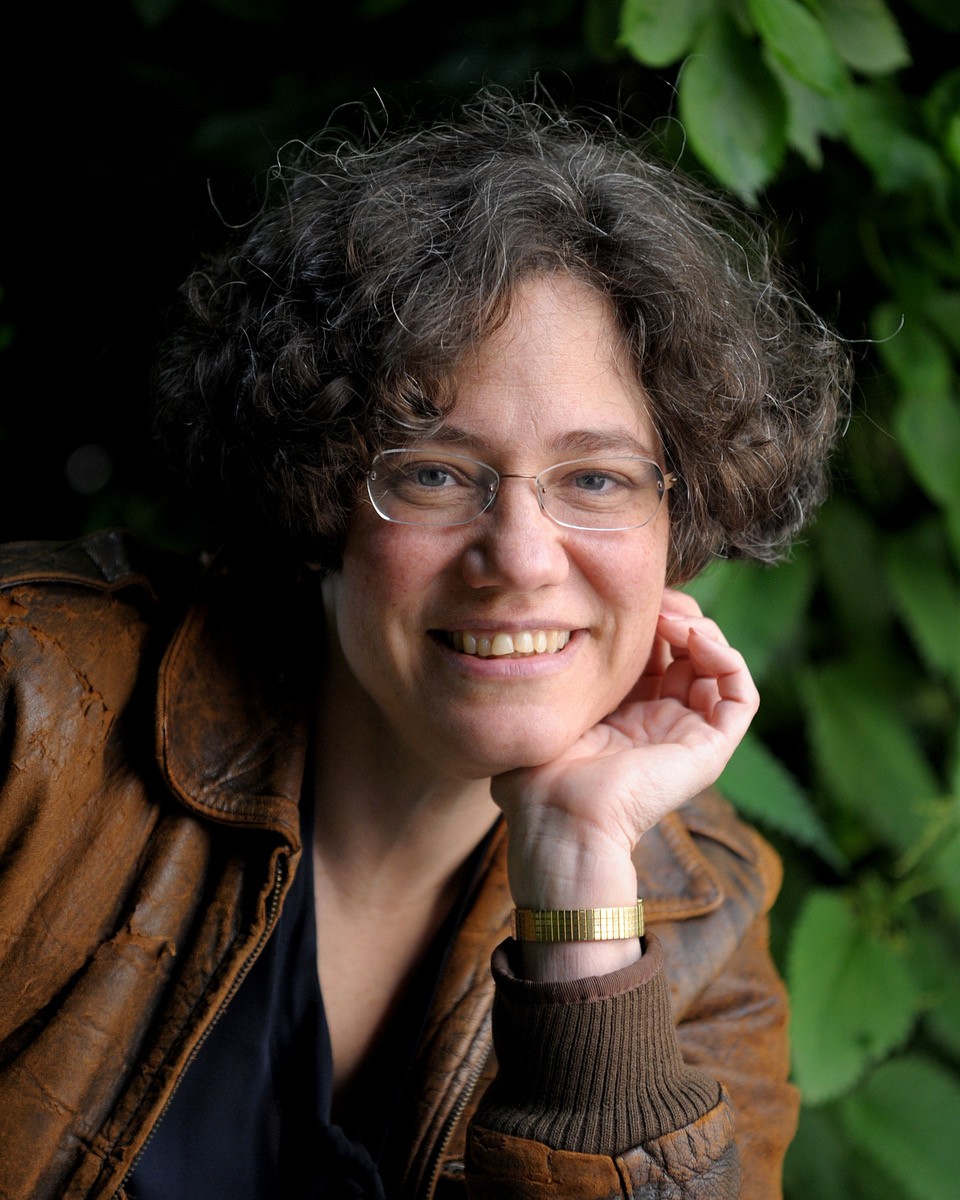 |
|
| Elizabeth Wein (photo: David Ho) |
|
Elizabeth Wein was born in New York and grew up in England, Jamaica, and Pennsylvania. She holds U.S. and British citizenship and has lived in Perth, Scotland, since 2000, where she earned her private pilot's license. Flight inspires her fiction, including the #1 New York Times bestseller Code Name Verity. Wein recently spoke with Shelf Awareness about her upcoming Hi-Lo series, War Birds, which follows young women pilots of different nationalities on their World War II journeys. The first three titles--Firebird, The Last Hawk, and White Eagles--are available in the U.S. from Union Square & Co.
What is a "Hi-Lo" reader?
Hi-Lo is a portmanteau to describe readers of "High interest age, Low reading ability." There are many reasons a teen might wind up in the "Hi-Lo" or reluctant reader category: dyslexia, learning difficulties, English as a second language, social and emotional issues. The idea of the Hi-Lo book is to provide accessible and interesting reading material to try to break the chain and make reading a pleasure rather than a struggle or a chore.
How is writing a Hi-Lo book different from writing a traditional novel for young readers, and how is it the same?
The writing is the same, but the editing is very different. I originally wrote the War Birds series for the Scottish publisher Barrington Stoke, who pioneered high-quality books aimed at dyslexic readers in the United Kingdom. I was hugely impressed with their encouragement during the writing process. I wrote as I'd write any novel, and then the text was edited to bring it in line with their reluctant reader guidelines. We broke up the story into sections containing short chapters and removed or changed words that are likely to trip up dyslexic readers. For example, we used the American spelling of czar rather than the British tsar. In decoding tsar it's easy to confuse it with star, whereas czar is merely unfamiliar and unlikely to be confused with another word.
I have heard in the past that Hi-Lo readers should have contemporary settings because historical or speculative settings challenge the readers too much. Does that line of thinking give the audience too little credit?
Aren't human storytelling traditions speculative through time and across cultures? Many gatekeepers forget that young readers of all kinds are already complex human beings. Loads of kids love speculative settings. A historical setting is no less difficult to take on board than fantasy in terms of the imaginative leaps it requires. I write both fantasy and historical fiction, and they're surprisingly similar in terms of worldbuilding. Experience has given me a good sense of what will confuse the reader, reluctant or not. One of my tricks is to include details that either directly relate to the world as the reader knows it or are fascinating because they contrast so hard with the reader's world.
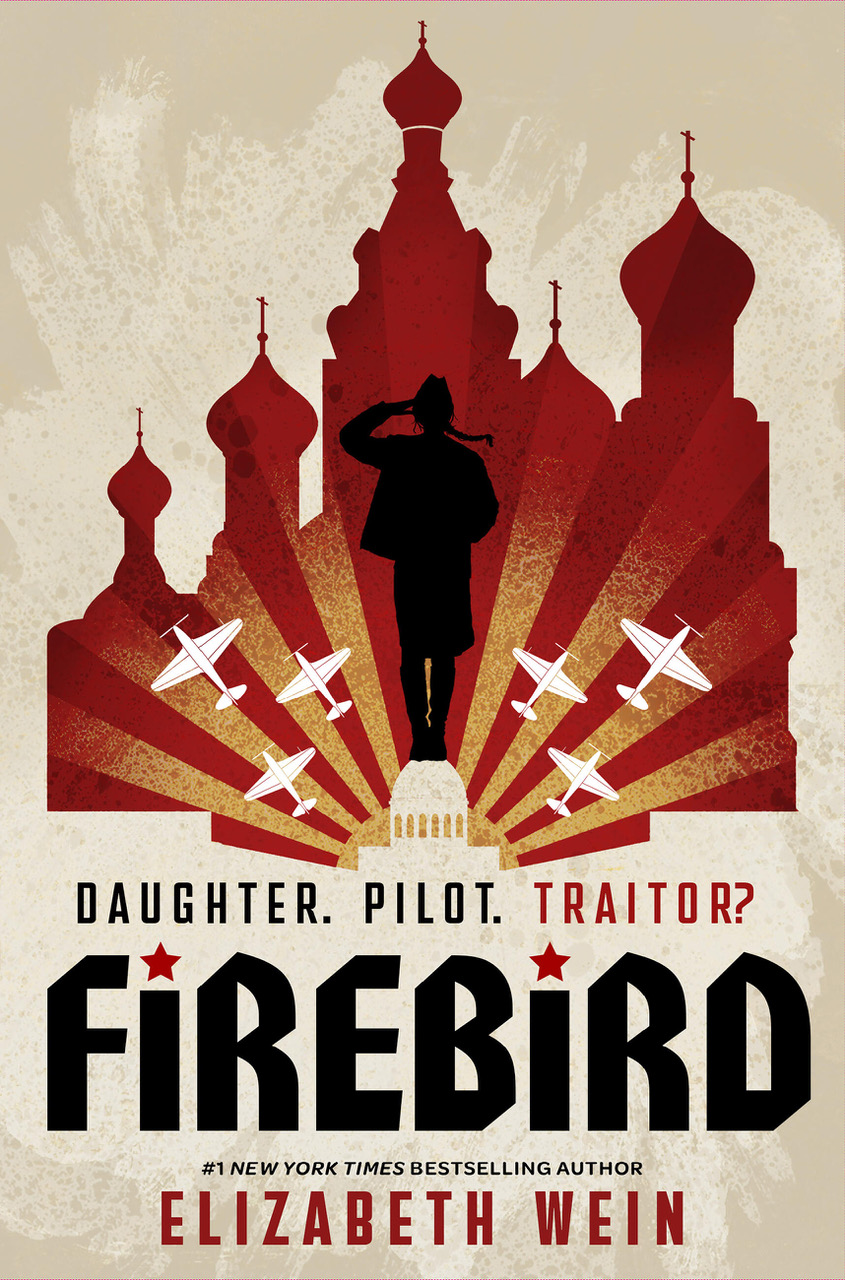 In Firebird, you tell the story of a young Soviet woman. Was it more difficult to find research sources on the USSR than Western Europe?
In Firebird, you tell the story of a young Soviet woman. Was it more difficult to find research sources on the USSR than Western Europe?
When Barrington Stoke asked if I'd write something like Code Name Verity for them, I was writing my first nonfiction for teens, A Thousand Sisters: The Heroic Airwomen of the Soviet Union in World War II. I was up to my ears in research on the USSR and its wartime aviators, so Firebird seemed a wonderful opportunity to make up my own story based on the real stories I was learning about.
It was more difficult to find mainstream sources on the Soviet women aviators than it is when researching Western topics, but we are lucky in that these women talked about themselves a lot. After Stalin's death, and with the relaxing of some of the restrictions the Soviet people had suffered under his terrifying regime, these women published memoirs, gave interviews, and even made movies about their wartime adventures. A surprising number of their memoirs have been translated into English. An American pilot named Anne Noggle, who'd been a member of the Women's Air Force Service Pilots during World War II, went to Russia in the early 1990s to meet her sisters-in-flight and interview them.
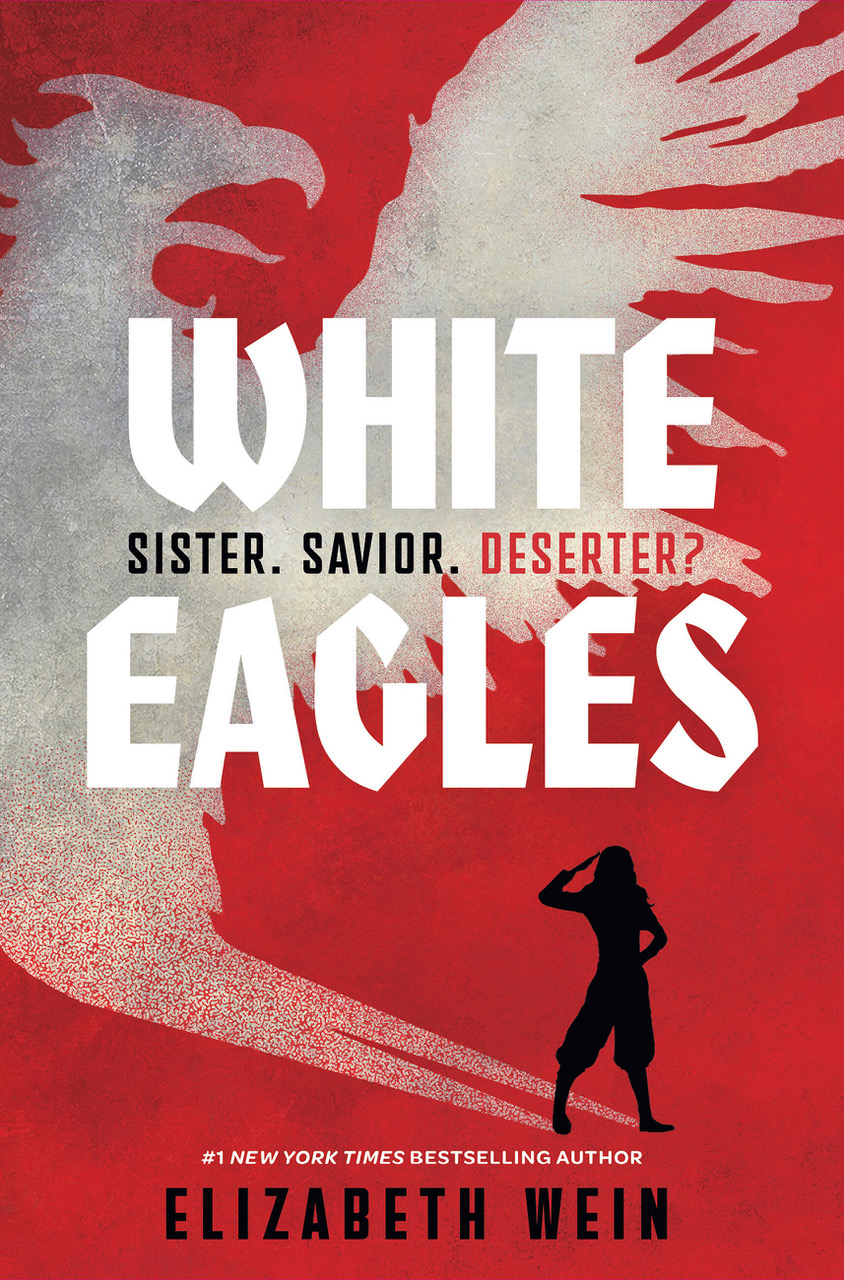 In White Eagles, the main character suffers a devastating loss. How did you balance her grief with the action to keep her choices as a character believable?
In White Eagles, the main character suffers a devastating loss. How did you balance her grief with the action to keep her choices as a character believable?
It felt instinctive. I have suffered enough loss in my life that I allowed Kristina to act as I felt she would naturally act under the circumstances. In a sense, I layered a part of myself into her character, something I no doubt do, usually without thinking about it, with all my characters.
One thing that I stumbled across which worked quite well to show Kristina's grief while still allowing her to act, was to put the voice of her lost loved one in her head BEFORE she loses him. This way, it feels quite natural to have him coaxing her along and teasing her in her imagination even after he's no longer with her--and her loss makes that remembered living voice more poignant. She acts in honorof her lost loved one, and to live up to his memory.
In The Last Hawk, the heroine must prove her worthiness to Germany when the Nazi Party's agenda threatens her values and her existence. What made this story an important one to tell for readers now?
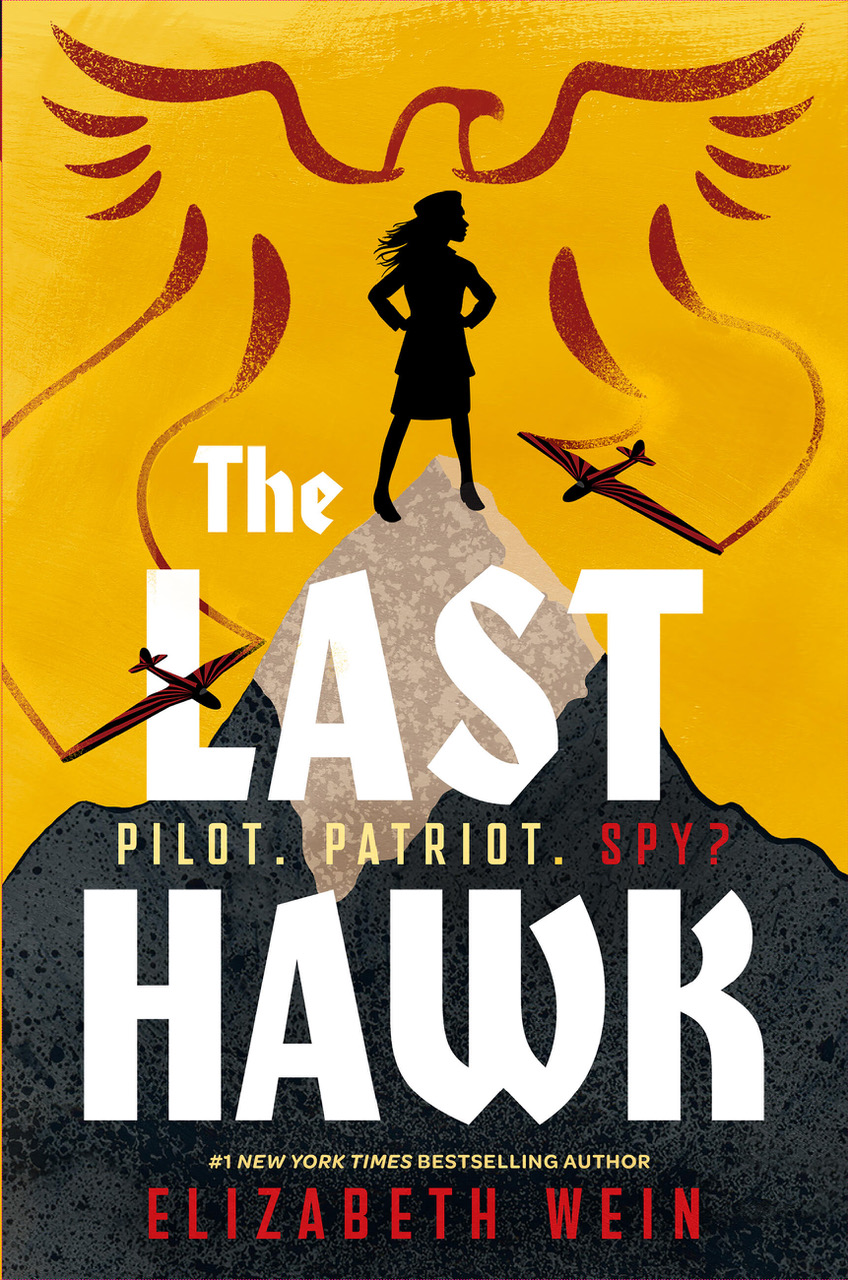 I don't like to be heavy-handed with moral messages in my stories, but if there's one hill I'm going to die on, it is "take responsibility for your own actions." This includes recognizing and atoning for your mistakes, which leads to the ability to change your mind and to choose another path. Increasingly, today's readers are under pressure to pick sides, as if everything that comes their way is a simple choice between opposites. That's rarely true. We're taught that it's courageous and honorable to stand up for the things we're taught to believe in, but it takes far more courage to question those beliefs and come to an individual conclusion. Individual integrity is as relevant and important in our time as it was in the past. It is relevant and important for all time.
I don't like to be heavy-handed with moral messages in my stories, but if there's one hill I'm going to die on, it is "take responsibility for your own actions." This includes recognizing and atoning for your mistakes, which leads to the ability to change your mind and to choose another path. Increasingly, today's readers are under pressure to pick sides, as if everything that comes their way is a simple choice between opposites. That's rarely true. We're taught that it's courageous and honorable to stand up for the things we're taught to believe in, but it takes far more courage to question those beliefs and come to an individual conclusion. Individual integrity is as relevant and important in our time as it was in the past. It is relevant and important for all time.
What do you feel the setting of World War II and the aviation world specifically have to teach modern youth?
I like to think these stories may inspire young people, and young women in particular, to think outside the box and investigate careers that might not seem obvious to them--aviation, but also a range of other things, as the young women do in these stories. I believe young people can be inspired in today's world by the actions of people in past times. The events in my stories and the women who inspired them were all real. At the heart of my storytelling is a desire to make people aware of the amazing unsung heroes and achievers who paved the way for us in another time, and who can continue to show us the way in our own time.
What projects can we expect to see from you next?
I'm working on a fantasy! I'm also hoping to write more nonfiction. I'm particularly fascinated by Antarctica at the moment, and I'm working on coming up with an angle to write about it. --Jaclyn Fulwood, youth services manager, Allen County Public Library
Book Candy
Book Candy
Mental Floss tells how to "Update Your Vocabulary With the Most-Searched Slang Terms of 2025."
---
The Public Domain Review featured highlights from Edward Lear's Nonsense Botany series, which were republished in an 1888 posthumous collection.
---
Gustave Doré's haunting illustrations of Dante's Divine Comedy were showcased by Open Culture.
Rediscover
Rediscover: Marian Burros
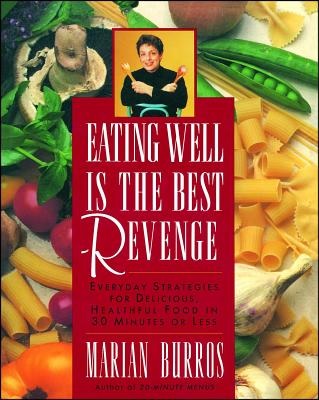 Marian Burros, a journalist and cookbook author whose reporting "gave new urgency to safety and health issues regarding food," died September 20 at age 92, the New York Times reported. As food editor of the Washington Star and the Washington Post in the 1970s, Burros "made consumer protection and food safety topics a focus, expanding the boundaries of traditional women's-page food writing to include not just recipes but also reporting on nutrition, truth in advertising and government policy."
Marian Burros, a journalist and cookbook author whose reporting "gave new urgency to safety and health issues regarding food," died September 20 at age 92, the New York Times reported. As food editor of the Washington Star and the Washington Post in the 1970s, Burros "made consumer protection and food safety topics a focus, expanding the boundaries of traditional women's-page food writing to include not just recipes but also reporting on nutrition, truth in advertising and government policy."
Marion Nestle, an emeritus professor of nutrition, food studies, and public health at New York University, noted that Burros "was hugely ahead of her time in writing about the importance of food choices that not only improve health but also are sustainable and protect the environment. She was writing about the politics of food long before anyone dreamed that a food movement might exist."
After graduating from Wellesley College with an English degree in 1954, Burros and Lois Levine, a friend, printed a collection of their home recipes on a mimeograph machine and sold it to local bookstores and through Wellesley's clubs nationwide. The collection was eventually published by Collier Books as Elegant but Easy: A Cookbook for Hostesses (1961), which sold half a million copies. A revised and updated version, The New Elegant but Easy Cookbook, was released in 1998.
She also collaborated with Levine on Second Helpings (1963) and Freeze With Ease (1965). Burros's own books include The Summertime Cookbook: Elegant but Easy Dining Indoors and Out (1972), Pure and Simple: Delicious Recipes for Additive-Free Cooking (1978), Eating Well Is the Best Revenge (1995), and Cooking for Comfort (2003).
Burros began writing a food column for Maryland News in 1962, and went on to become food editor at the Washington Daily News and the Washington Star before the Washington Post hired her as its food editor in 1974. She joined the Times in 1981 and continued to employ her approach that combined recipe writing with investigative reporting.
"She might offer a recipe for, say, Martha Washington's Great Cake, usually in the weekly De Gustibus column, which she took over in 1983, while reporting on a sodium labeling bill being debated in Congress or regulatory battles over the wording of federal dietary guidelines," the Times wrote.
Her plum torte was one of the most popular recipes in the history of the newspaper. "It is beyond understanding why fans of the recipe do not just save it from year to year, instead of depending on its appearance in this column," she wrote when the torte ended its seven-year run in 1989. "Yet one of this year's requests read, 'Isn't it about time for the plum torte recipe?' "
Burros retired in 2008, but continued writing freelance articles. "Her reporting made her a leading voice in the rising consumer movement. She was known as a ruthless interrogator of food industry claims and a highly skeptical reader of ingredient labels," the Times noted.

